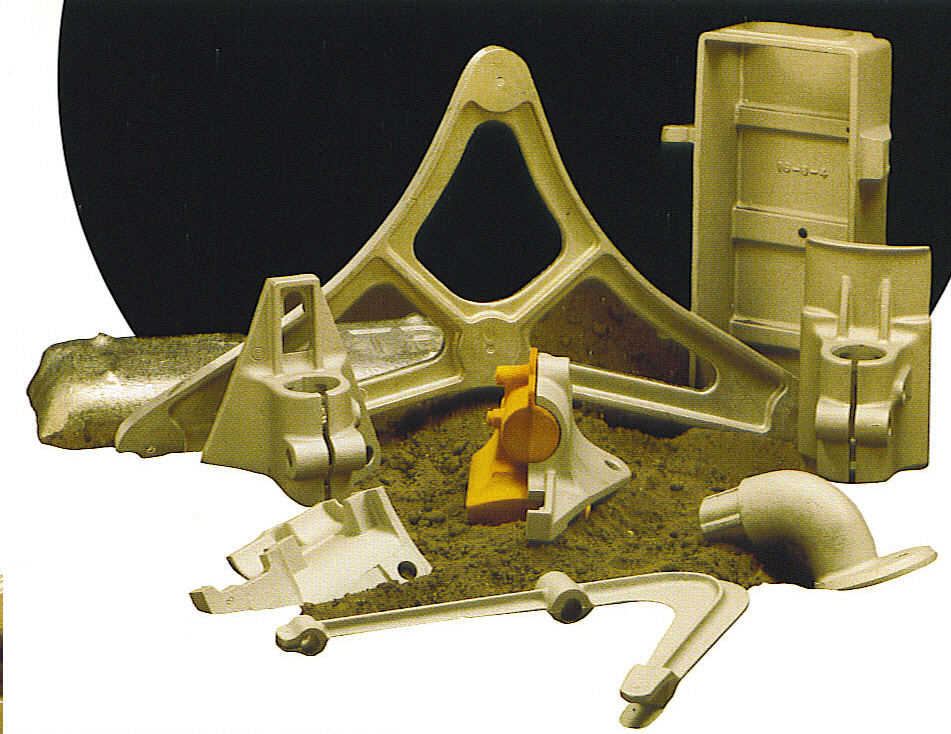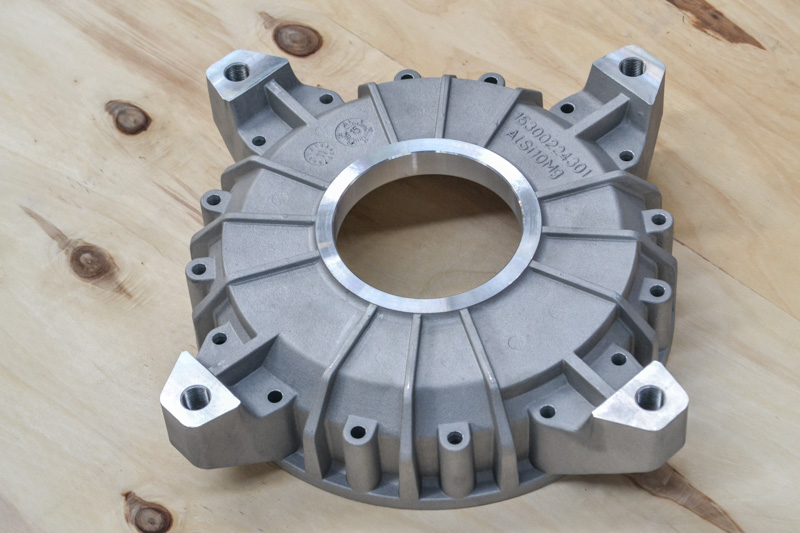How precision Metal Castings help better engineering results
Wiki Article
Discovering the Benefits and Practical Use Aluminum Castings in Today's Market
Light weight aluminum spreadings have ended up being progressively pertinent in various markets because of their special features. Their lightweight nature and resistance to rust make them appropriate for demanding applications. Furthermore, the remarkable strength-to-weight proportion uses considerable advantages in design and production. As markets remain to explore their potential, the complete scope of aluminum castings' advantages and applications remains to be completely discovered. What lies in advance for this functional material?The Lightweight Advantage of Light Weight Aluminum Castings
Several materials are made use of in production, light weight aluminum spreadings stand out mainly due to their light-weight properties. This particular makes light weight aluminum spreadings an eye-catching option for various markets, particularly in aerospace and vehicle applications, where weight decrease is crucial for enhancing gas performance and performance. The light-weight nature of aluminum enables manufacturers to develop components that are much easier to deal with and install, inevitably decreasing labor expenses.The capacity to generate complex shapes without substantial weight charges allows developers to introduce while maintaining structural integrity. Light weight aluminum castings can efficiently change much heavier materials, leading to considerable financial savings in delivery and functional costs. Their light-weight benefit additionally adds to enhanced product durability, as lighter elements frequently cause reduced wear and tear on equipment. On the whole, the lightweight homes of aluminum castings offer manufacturers with a competitive side, cultivating innovations in product layout and performance across different fields.

Outstanding Rust Resistance
Aluminum spreadings possess an all-natural resistance to oxidation, which considerably improves their longevity in numerous atmospheres. This intrinsic residential property not just adds to their toughness but also lines up with the lightweight benefit that light weight aluminum provides. Therefore, light weight aluminum spreadings are significantly recognized for their phenomenal deterioration resistance in many applications.
Normally Resistant to Oxidation
One of the standout qualities of aluminum castings is their outstanding deterioration resistance, which stems from an all-natural oxidation process. When revealed to air, aluminum reacts to form a thin, safety layer of aluminum oxide. This layer acts as a barrier versus further oxidation and protects the underlying steel from destructive aspects such as dampness and salts. Unlike other steels, this oxide layer is self-repairing; if damaged, it quickly reforms when revealed to air. This one-of-a-kind building boosts the longevity of aluminum castings in different atmospheres, making them optimal for applications in industries such as aerospace, auto, and marine. Consequently, the all-natural resistance to oxidation greatly decreases maintenance expenses and increases the integrity of light weight aluminum spreadings in requiring conditions.Light-weight Resilience Advantage
The light-weight nature of light weight aluminum spreadings adds greatly to their sturdiness, making them a helpful option in numerous markets. This remarkable resilience is mostly associated to aluminum's innate resistance to corrosion, which is boosted better via anodizing and various other surface area treatments. Unlike many steels, aluminum does not rust; instead, it creates a safety oxide layer that shields it from ecological damages. This building is especially useful in industries such as automotive and aerospace, where weight decrease is critical without jeopardizing strength. In addition, the durability of aluminum spreadings decreases maintenance costs and replacements, supplying economic advantages gradually. Their lightweight sturdiness and corrosion resistance setting light weight aluminum castings as a premium product for contemporary production applications.
Superior Strength-to-Weight Ratio
An exceptional characteristic of aluminum spreadings is their premium strength-to-weight ratio, which makes them highly desirable in different applications. This intrinsic home permits aluminum spreadings to withstand significant stress and anxiety while remaining lightweight, a vital variable in markets such as aerospace, auto, and manufacturing. Engineers typically favor light weight aluminum castings for parts that call for both resilience and decreased weight, improving fuel performance and performance.The high strength-to-weight ratio also helps with the style of elaborate forms and frameworks, making light weight aluminum castings versatile for complex applications. In addition, the capacity to keep architectural stability under difficult conditions warranties long life and reliability in items, from aircraft frameworks to automotive components. This benefit adds to the expanding trend of using light weight aluminum castings in innovative designs, ultimately bring about boosted performance and efficiency throughout varied industries. The superior strength-to-weight proportion of aluminum spreadings positions them as an essential material in contemporary design and manufacturing.
Cost-Effectiveness in Manufacturing
Cost-effectiveness in aluminum spreading production is largely attained via reduced product waste and effective manufacturing processes. By enhancing designs and using innovative techniques, suppliers can reduce excess product use while keeping quality requirements. This strategy not only decreases production costs however additionally adds to much more lasting practices within the industry.Minimized Product Waste
Reducing product waste in aluminum casting processes substantially enhances production performance. By optimizing the design and manufacturing methods, business can lessen excess scrap and improve resource usage. This reduction in waste not only reduces material prices however also adds to a much more sustainable production version. The capacity to reuse aluminum additional assistances cost-effectiveness, enabling producers to redeem and reuse materials without jeopardizing high quality. As the industry increasingly concentrates on sustainability, reduced product waste straightens with ecological goals while concurrently improving productivity. Ultimately, efficient use basic materials reinforces the competitive position of services out there, making aluminum spreadings a desirable alternative in various applications. The tactical strategy to lessening waste shows a dedication to both financial and environmental obligation.Efficient Production Processes
While standard production processes can sustain substantial expenses, aluminum spreading supplies a much more reliable option that boosts general manufacturing profitability. This approach reduces product waste and permits specific control over the production process, resulting in decreased labor and functional expenses. The ability to generate complex forms with fewer steps additionally enhances production, adding to shorter lead times. Furthermore, light weight aluminum's lightweight nature and superb thermal conductivity permit energy financial savings throughout manufacturing and in the last application. By utilizing modern spreading modern technologies, makers can achieve greater throughput without giving up high quality. As a result, light weight aluminum spreading stands out as an affordable solution, making it an eye-catching choice for services aiming to enhance their production procedures in today's affordable market.Flexibility Throughout Industries
Aluminum spreadings demonstrate impressive versatility throughout various markets, as they can be tailored to satisfy details needs and applications. In the automobile field, light weight aluminum castings are made use of in engine blocks, transmission housings, and wheels, offering lightweight yet durable services that improve fuel performance. The aerospace sector likewise takes advantage of light weight aluminum spreadings, utilizing them in structural parts and engine components because of their strength-to-weight ratio.In the durable goods industry, producers use light weight aluminum castings for items ranging from cooking equipment to furnishings, providing both aesthetic appeal and performance. The electronics sector uses aluminum spreadings for real estates and warm sinks, guaranteeing effective thermal monitoring. Furthermore, the construction sector leverages light weight aluminum castings for architectural aspects and structural elements, improving sturdiness and layout versatility. This broad applicability highlights light weight aluminum castings as a vital source, satisfying the varied requirements of various markets while preserving high efficiency and dependability.
Sustainability and Ecological Effect
As sectors progressively focus on lasting methods, light weight aluminum spreadings arise as a green selection due to their recyclability and low ecological footprint. Aluminum is among the most recycled products around the world, with the ability to be repurposed several times without destruction of top quality. This particular greatly decreases the demand for resources and energy consumption connected with primary aluminum production, which is energy-intensive.Furthermore, light weight aluminum spreadings add to light-weight layouts, leading to fuel effectiveness in transportation applications such as aerospace and automotive industries. Their sturdiness and resistance to rust prolong product life expectancies, further reducing waste and resource usage over time. Furthermore, many makers are embracing accountable sourcing and ecologically friendly production approaches, boosting the sustainability of aluminum spreading procedures. Generally, light weight aluminum castings stand for a functional service for businesses aiming to reduce their ecological effect while achieving performance and efficiency.
Technologies in Light Weight Aluminum Casting Technologies
Recent improvements in aluminum casting technologies have actually considerably boosted the efficiency and quality of production processes. Advancements such as 3D printing and progressed mold-making methods have actually allowed manufacturers to create detailed styles with lowered material waste. This shift not only improves the precision of cast parts yet also shortens preparations, permitting fast prototyping and faster market entry.
Moreover, the consolidation of advanced computer simulations help in forecasting potential issues during casting, resulting in higher-quality results (Metal Castings). Using lightweight alloys has actually likewise added to the growth of more powerful, a lot more long lasting products, dealing with sectors ranging from auto to aerospace
Additionally, automated spreading procedures have arised, reducing human error and increasing manufacturing rate. Jointly, these developments are transforming the light weight aluminum spreading landscape, driving greater competition and sustainability in manufacturing. As markets remain to evolve, these modern technologies will certainly play a vital role in conference future needs for effectiveness and quality.
Often Asked Questions
Exactly How Do Aluminum Castings Compare to Various Other Metals in Regards To Thermal Conductivity?
Aluminum castings show exceptional thermal conductivity contrasted to many steels, such as steel and iron - Aluminum Foundry. Their light-weight nature and reliable warm distribution make them excellent for applications requiring effective thermal management in numerous marketsWhat Are the Typical Flaws Located in Aluminum Castings?
Usual issues in light weight aluminum castings consist of porosity, shrinkage, incorporations, and surface area abnormalities. These concerns typically occur from inappropriate air conditioning rates, poor mold and mildew design, or contaminations, impacting the total quality and performance of the end product.Can Light Weight Aluminum Castings Be Recycled, and Just how?
Aluminum spreadings can be reused effectively. The procedure involves accumulating, melting, and reforming the light weight aluminum, which decreases waste and saves resources. This recycling adds to sustainability while maintaining the product's properties for future usage.What Are the Regular Lead Times for Aluminum Casting Manufacturing?
Normally, preparations for light weight aluminum spreading manufacturing array from 2 to 6 weeks, relying on factors such as complexity, tooling demands, and manufacturing volume. Efficiency can improve with recognized vendor partnerships and maximized production procedures.Exactly how Does the Surface End Up Affect Light Weight Aluminum Spreading Performance?
The surface finish significantly Aluminum Foundry affects aluminum spreading efficiency by influencing corrosion resistance, visual top quality, and friction qualities. A smoother finish boosts longevity and capability, while a rougher structure can improve attachment for subsequent coverings or treatments.Several materials are used in production, aluminum spreadings stand out mostly due to their lightweight properties. When subjected to air, aluminum responds to develop a thin, safety layer of light weight aluminum oxide. Cost-effectiveness in aluminum spreading manufacturing is mostly achieved with reduced product waste and efficient production procedures. Decreasing product waste in aluminum spreading procedures considerably enhances manufacturing effectiveness. Inevitably, effective usage of raw materials enhances the affordable setting of businesses in the market, making light weight aluminum spreadings a favorable choice in numerous applications.
Report this wiki page